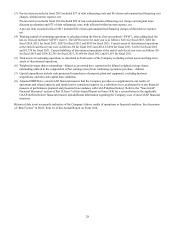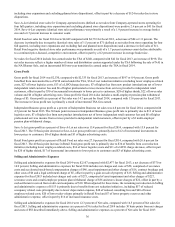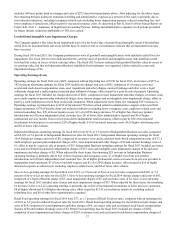Albertsons 2015 Annual Report Download - page 38
Download and view the complete annual report
Please find page 38 of the 2015 Albertsons annual report below. You can navigate through the pages in the report by either clicking on the pages listed below, or by using the keyword search tool below to find specific information within the annual report.36
including store expansions and excluding planned store dispositions), offset in part by a decrease of $124 in sales due to store
dispositions.
Save-A-Lot identical store sales for Company-operated stores (defined as net sales from Company-operated stores operating for
four full quarters, including store expansions and excluding planned store dispositions) were positive 2.6 percent or $41 for fiscal
2014. Save-A-Lot corporate identical store sales performance was primarily a result of a 1.9 percent increase in average basket
size and a 0.7 percent increase in customer count.
Retail Food net sales for fiscal 2014 were $4,649 compared with $4,733 for fiscal 2013, a decrease of $84 or 1.8 percent. The
decrease is primarily due to negative identical store sales of 1.5 percent or $71 (defined as net sales from stores operating for four
full quarters, including store expansions and excluding fuel and planned store dispositions) and a decrease in fuel sales of $11.
Retail Food negative identical store sales performance was primarily a result of a 1.7 percent customer count decline attributable
to a continued price-focused, competitive environment, offset in part by a 0.2 percent increase in average basket size.
Net sales for fiscal 2014 include fees earned under the TSA of $240, compared with $42 for fiscal 2013, an increase of $198. The
net sales increase reflects a higher number of stores and distribution centers supported under the TSA following the sale of NAI in
the NAI Banner Sale, and an incremental $60 one-year transition fee earned under the TSA in fiscal 2014.
Gross Profit
Gross profit for fiscal 2014 was $2,530, compared with $2,333 for fiscal 2013, an increase of $197 or 8.4 percent. Gross profit
benefited from incremental fees of $198 earned under the TSA, $34 of cost reduction initiatives including lower employee-related
costs, $27 of lower logistics costs, $13 of a LIFO charge decrease, $7 of higher fees from new product introductions net of lower
independent retail customer fees and $6 of higher professional services income from services provided to independent retail
customers, offset in part by $30 of incremental investments to lower prices to customers, $28 of higher shrink, $22 of lower sales
volume and $6 of higher advertising costs. Gross profit for fiscal 2014 also includes a multi-employer pension plan withdrawal
charge of $3. Gross profit as a percent of Net sales was 14.7 percent for fiscal 2014, compared with 13.6 percent for fiscal 2013.
The increase in Gross profit rate is primarily a result of incremental TSA fees earned.
Independent Business gross profit as a percent of Independent Business net sales was 4.8 percent for fiscal 2014, compared with
4.5 percent for fiscal 2013. The 30 basis point increase in Independent Business gross profit rate is primarily due to $13 of lower
logistics costs, $7 of higher fees from new product introductions net of lower independent retail customer fees and $6 of higher
professional services income from services provided to independent retail customers, offset in part by a $3 multi-employer
pension plan withdrawal charge.
Save-A-Lot gross profit as a percent of Save-A-Lot net sales was 15.4 percent for fiscal 2014, compared with 15.9 percent for
fiscal 2013. The 50 basis point decrease in Save-A-Lot gross profit rate is primarily due to $12 of incremental investments to
lower prices to customers, $8 of higher shrink and $3 of higher advertising costs.
Retail Food gross profit as a percent of Retail Food net sales was 27.0 percent for fiscal 2014, compared with 26.6 percent for
fiscal 2013. The 40 basis point increase in Retail Food gross profit rate is primarily due to $34 of benefits from cost reduction
initiatives including lower employee-related costs, $14 of lower logistics costs and $11 of a LIFO charge decrease, offset in part
by $20 of higher shrink, $17 of incremental investments to lower prices to customers and $3 of higher advertising costs.
Selling and Administrative Expenses
Selling and administrative expenses for fiscal 2014 were $2,107 compared with $2,477 for fiscal 2013, a net decrease of $370 or
14.9 percent. Selling and administrative expenses for fiscal 2014 includes net charges and costs of $58, comprised of severance
costs and accelerated stock-based compensation charges of $46, asset impairment and other charges of $16, contract breakage and
other costs of $6 and a legal settlement charge of $5, offset in part by a gain on sale of property of $15. Selling and administrative
expenses for fiscal 2013 included net charges and costs of $275, comprised of asset impairment and other charges of $227,
severance costs and a multi-employer pension plan withdrawal charge of $36 and store closure charges of $22, offset in part by a
cash settlement received from credit card companies of $10. When adjusted for these items, the remaining net reduction in Selling
and administrative expenses of $153 is primarily due to benefits from cost reduction initiatives, including $57 of reduced
occupancy related costs principally due to lower depreciation expense, $48 of reduced consulting fees and $40 of lower
employee-related costs, $20 of lower sales volume primarily in Retail Food and $7 of lower property reserves and other
administrative expense, offset in part by $16 of increased insurance costs.
Selling and administrative expenses for fiscal 2014 were 12.3 percent of Net sales, compared with 14.5 percent of Net sales for
fiscal 2013. Selling and administrative expenses as a percent of Net sales for fiscal 2014 includes 30 basis points from net charges
and costs of $58 described immediately above. Selling and administrative expenses as a percent of Net sales for fiscal 2013
























